
Heterocrossa ignobilis is a species of moth in the family Carposinidae. It was described by Alfred Philpott and is endemic to New Zealand and has been observed in Canterbury, in the South Island. Adults are on the wing in January.

Heterocrossa epomiana is a species moth in the family Carposinidae. It is endemic to New Zealand and has been observed in Westland. Adults are on the wing in January. This species is visually very similar to H. gonosemana and to H. philpotti.

Scoparia acharis is a moth of the family Crambidae. It was named by Edward Meyrick in 1884. This species is endemic to New Zealand and has been observed in both the North and South Islands. The preferred habitat of this species is native forest and in the South Island S. acharis has been observed in beech forest. The larval host of this species is moss. Adults are most commonly on the wing from November to January, although this species has been observed from October until March.
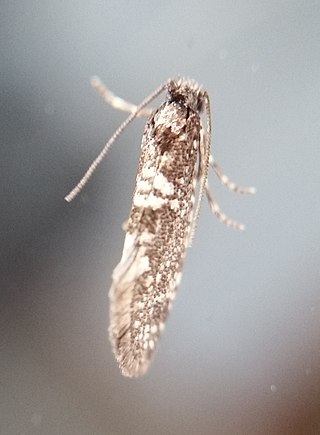
Scoriodyta conisalia is a species of moth in the family Psychidae. It was described by Edward Meyrick in 1888. It is endemic to New Zealand and can be found in the North Island. It has been observed at Karikari, Paihia, in the Poor Knights Islands, and in the Auckland and Wellington regions. The species inhabits native forest and coastal areas where it can be found on rocky outcrops and cliffs. Larvae consume algae and lichens. The adults are on the wing from September to March and are active before sunrise.

Trachypepla semilauta is a moth of the family Oecophoridae and was first described by Alfred Philpott in 1918. It is endemic to New Zealand and has been collected in Southland. This species inhabits southern beech forest on the side of mountains. Adults are on the wing in January.
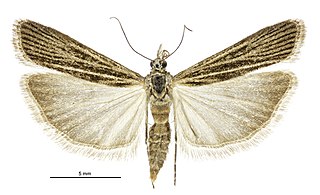
Eudonia atmogramma is a moth in the family Crambidae. It was described by Edward Meyrick in 1915. It is endemic to New Zealand.
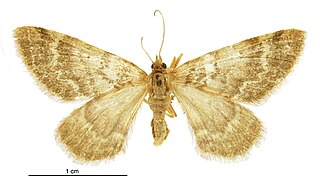
Asaphodes aphelias is a species of moth in the family Geometridae. It is endemic to New Zealand and has been observed in Fiordland. This species inhabits damp native scrub and has been observed in upland wetlands at altitudes of between 800 and 1100 m. Adults are on the wing in February but the female of this species is unusual as it has narrow fore and hind wings.

Mallobathra tonnoiri is a moth of the family Psychidae. It was described by Alfred Philpott in 1927. This species is endemic to New Zealand and has been observed in the South Island. Adults are on the wing in December.

Tingena anaema is a species of moth in the family Oecophoridae. It is endemic to New Zealand and has been collected at Lake Wakatipu, Invercargill and Stewart Island / Rakiura. The adults of the species are on the wing in December.

Tingena letharga is a species of moth in the family Oecophoridae. It is endemic to New Zealand and has been observed in Otago. Adults are on the wing in December and January.

Tingena opaca is a species of moth in the family Oecophoridae. It is endemic to New Zealand and has been observed in the southern parts of the South Island. Adults of this species are on the wing in December.
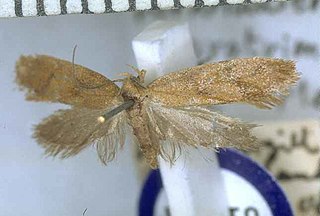
Tingena paratrimma is a species of moth in the family Oecophoridae. It is endemic to New Zealand and has been observed in the lower parts of the South Island. George Hudson regarded this species are uncommon. The adults of this species are on the wing from November to February.

Tingena penthalea is a species of moth in the family Oecophoridae. It is endemic to New Zealand and has been observed in Wellington and the Tararua Range. The adults of this species are on the wing from December until February.
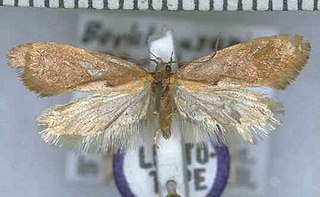
Tingena perichlora is a species of moth in the family Oecophoridae. It is endemic to New Zealand and has been observed in the southern parts of the South Island. This species appears to inhabit manuka scrub. Adults of this species are on the wing from October to January.

Tingena pharmactis is a species of moth in the family Oecophoridae. It is endemic to New Zealand and has been observed in the Nelson, Tasman and Wellington regions. The adults of this species are on the wing in December.

Atomotricha isogama is a moth in the family Oecophoridae. It was first described by Edward Meyrick in 1909. This species is endemic to New Zealand and has been observed in the North and South Islands. Larvae are leaf litter feeders and have been recorded as emerging in the New Zealand spring. Adults have been observed on the wing from July to January.

Trachypepla leucoplanetis is a moth of the family Oecophoridae first described by Edward Meyrick in 1883. It is endemic to New Zealand and has been collected in both the North and South Islands. It is the smallest moth species in the genus Trachypepla and the patterns on the forewings of adults are variable in appearance. It inhabits native forest and bush and the larvae feed on leaf litter. Adults are on the wing from October until February. T. leucoplanetis is regarded as being rarely observed and has been collected via the beating of foliage.

Trachypepla lichenodes is a moth of the family Oecophoridae first described by Edward Meyrick in 1883. It is endemic to New Zealand and has been found in both the North and South Islands. It inhabits native forest and adults of this species are on the wing from November to January. The adult moths are similarly coloured to native lichen species however this colouration is variable in the extent and depth on the forewings.

Trachypepla protochlora is a moth of the family Oecophoridae first described by Edward Meyrick in 1883. It is endemic to New Zealand and is found in both the North and South Islands. The preferred habitat of this species is native forest and adults are on the wing from October until February. Adults can be variable in their green shaded colour as well as in the intensity of markings on their forewings. The greenish ground colouration of this moth ensures they are well camouflaged when at rest on green mosses and lichens.

Orthenches disparilis is a moth of the family Plutellidae. This species was first described by Alfred Philpott in 1931. It is endemic to New Zealand and has been observed in Auckland and Otago. O. disparilis is associated with species in the genus Corokia and larvae are known to feed on Corokia buddleioides. The larvae mine the leaves and feeds on the shoots and fruit of their host. Adults are on the wing in January. Dracophyllum bushes are used as over wintering sites by the adults.






















